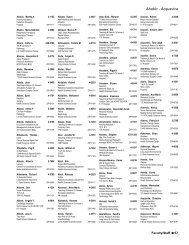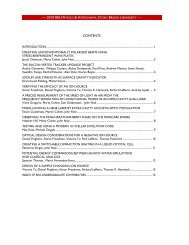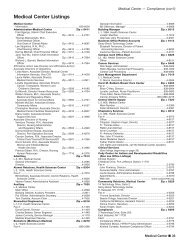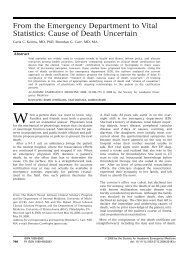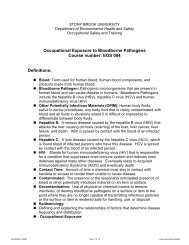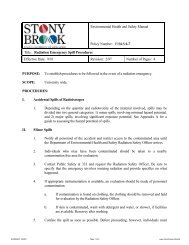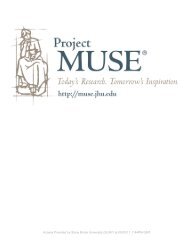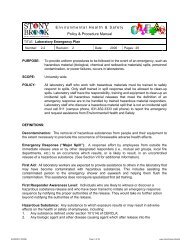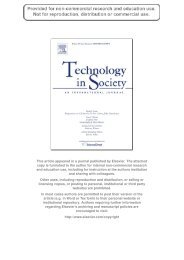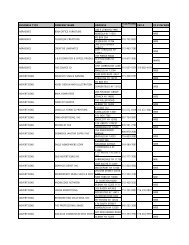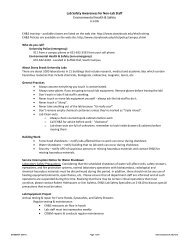Planning Guide - Stony Brook University
Planning Guide - Stony Brook University
Planning Guide - Stony Brook University
Create successful ePaper yourself
Turn your PDF publications into a flip-book with our unique Google optimized e-Paper software.
HIS 101 European History:<br />
from Antiquity to Revolution<br />
An introduction to the ideas and institutions of<br />
“the West” from the beginnings of civilization to<br />
the French Revolution. Topics include ancient<br />
cultures; the rise of Christianity; medieval politics<br />
and society, Renaissance art and thought; the<br />
Reformation and Counter-Reformation; the new<br />
science; absolutism and the modern state; and<br />
the Enlightenment.<br />
HIS 103 American History to 1877<br />
A survey of American history from the Age of<br />
Discovery to the end of Reconstruction. Topics<br />
include the transplantation of European culture<br />
to America, the rise of American nationalism,<br />
the democratization of American society, the<br />
institution of slavery, and the emergence of an<br />
industrial society.<br />
HIS 104 United States Since 1877<br />
A survey of modern American history from the<br />
end of Reconstruction to the present. The<br />
course focuses on the impact of industrialization<br />
on social, cultural, and political life; the<br />
emergence of the United States as a world<br />
power; and the adaptation of that power to the<br />
crises of the later 20th century.<br />
LIN 101 Introduction to Linguistics<br />
An introduction to the fundamental areas and<br />
concepts of modern linguistics. Sounds and<br />
their structure, word structure, and sentence<br />
structure are discussed. Other topics may<br />
include historical linguistics (how languages<br />
change over time), dialects, writing systems,<br />
and psycholinguistics (especially the question<br />
of how children acquire a language).<br />
POL 101 World Politics<br />
Analysis of the basic concepts and issues of<br />
international relations in the contemporary<br />
international system. The behaviors of states<br />
and their decision makers are considered<br />
according to various models of national and<br />
international conflict. The relationship between<br />
the characteristics of nations and their foreign<br />
policies is studied on a comparative basis.<br />
POL 102 Introduction to<br />
American Government<br />
What the informed citizen and specialist should<br />
know about the organization of American government,<br />
including the Constitution and what it<br />
means today, the Congress, political parties,<br />
pressure groups, growth of the presidency, the<br />
14<br />
Supreme Court, judicial review, federalism, separation<br />
of powers, and the Bill of Rights.<br />
POL 103 Introduction to<br />
Comparative Politics<br />
Analysis of political institutions and processes<br />
in the contemporary world, emphasizing the<br />
interaction of political structures and processes<br />
in a variety of political settings.<br />
PSY 103 Introduction to Psychology<br />
An introduction to research and theory in psychology<br />
in such areas as learning, perception,<br />
cognition, biopsychology, development, personality,<br />
and abnormal and social psychology. As<br />
part of the course, students must participate in<br />
experiments and/or a library research project.<br />
SOC 105 Introduction to Sociology<br />
A general introduction to the science of sociology,<br />
emphasizing sociological theory and methods.<br />
Students are taught what is unique about<br />
the way in which sociologists analyze human<br />
behavior and society. Differences between the<br />
sociological perspective and perspectives of<br />
other social sciences are emphasized. There is<br />
also a heavy emphasis on the types of methods<br />
and data that sociologists use to test the validity<br />
of their ideas.<br />
WST 102 Introduction to Women’s<br />
Studies in the Social Sciences<br />
An introductory social sciences survey examining<br />
the continuities and changes women<br />
have made in marriage systems, child-rearing<br />
practices, and work patterns inside and outside<br />
the home. Within this context, the course<br />
considers how women have balanced labor<br />
force participation and changing child-care<br />
responsibilities in a variety of countries. Using<br />
the experimental design and case study methods<br />
of anthropology, sociology, economics,<br />
psychology, and history, and employing texts<br />
drawn from these disciplines, the course<br />
shows the changes women have undergone<br />
over the past 150 years.<br />
FINE AND PERFORMING<br />
ARTS COURSES<br />
ARH 101 Art in Culture from<br />
Prehistoric Times to the Age of the<br />
Cathedrals, ca. 1400 A.D.<br />
A survey of the history of painting, sculpture,<br />
and architecture from its beginnings in prehistoric<br />
times to the end of the Middle Ages.Works<br />
of art are studied both as individual monuments<br />
with intrinsic aesthetic appeal and as<br />
expressions of the needs, ideals, and aspirations<br />
of the particular society in which they<br />
were created.<br />
ARH 102 Art in Culture from the<br />
Early Renaissance, ca. 1400, to<br />
Postmodernism<br />
A survey of the history of painting, sculpture,<br />
and architecture from the Renaissance to the<br />
present day. Works of art are studied both as<br />
individual monuments with intrinsic aesthetic<br />
appeal and as expressions of the needs, ideals,<br />
and aspirations of the particular society in<br />
which they were created.<br />
ARS 154 Foundations of Drawing<br />
Fundamentals of drawing using various drawing<br />
media and types of paper. Perspective, foreshortening,<br />
proportion, anatomy, and basic concepts<br />
of drawing are studied.The figure, still life,<br />
and landscape are explored as subject matter,<br />
and color theory is introduced.<br />
DAN 102 Introduction to World<br />
Dance Cultures<br />
An introduction to the properties and elements<br />
of dance to understand and appreciate it in a<br />
variety of contexts. Dance is considered as art,<br />
recreation, social interaction, and entertainment<br />
through investigation of societal attitudes, cultural<br />
norms, and creative styles of individuals.<br />
LIA 101 Introduction to the<br />
Interdisciplinary Arts<br />
An exploration of the interdisciplinary and collaborative<br />
nature of the fine arts. The course<br />
traces the general development of the arts from<br />
their common practical origins in basic communication,<br />
ritual, and decoration to the present,<br />
and examines how these factors unify the arts in<br />
modern culture and society. Students develop<br />
in-class presentations using multiple art forms.<br />
MUS 101 Introduction to Music<br />
The basic concepts of music such as melody,<br />
harmony, rhythm, counterpoint, and form are<br />
studied through investigation of the historical<br />
and contemporary masterpieces of the Western<br />
classical tradition, of various non-Western<br />
musics, and of various “popular” traditions. The<br />
different styles and types of music are considered<br />
not only in light of the cultural values they<br />
embody, but also in relation to present-day cultural<br />
and musical values. No previous musical<br />
training is assumed.<br />
MUS 119 The Elements of Music<br />
Beginning with the rudiments of music, such as<br />
meter, tempo, rhythm, and how to read notes in<br />
several clefs, this “hands-on” course goes on<br />
to examine how music is organized, covering<br />
scales, keys, intervals, chords, form, and style<br />
in classical music. Students also compose<br />
throughout the semester and sharpen their listening<br />
skills through attendance at concerts.<br />
THR 100 Performing and Performance<br />
Study and practice in performance and communications:<br />
interpersonal communication, public<br />
presentations, and theatrical performance.<br />
THR 101 Understanding Theatre<br />
An overview of performance, design, and production<br />
in the theatre. Specific texts are<br />
explored through lectures, demonstrations, and<br />
a close examination of the rehearsal process.<br />
Professionals working in the theatre are invited<br />
to speak on such topics as stage management,<br />
technical production, and direction.<br />
THR 105 Acting<br />
The basic vocabulary and skills of the actor’s<br />
craft. Students explore acting techniques<br />
through theatre games and improvisation.



